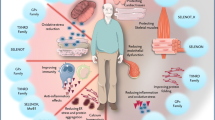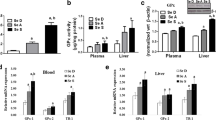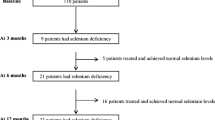Abstract
Keshan disease is a cardiomyopathy restricted to the endemic areas of China and seen in residents having an extremely low selenium (Se) status. Prophylactic administration of sodium selenite has been shown to decrease significantly the incidence of acute and subacute cases. The aim of the study was to assess the relative bioavailability of selenite versus organic Se-yeast in a Se-deficient area in China with a randomized double-blind double-dummy design.
Healthy children (n=30) between 14 and 16 yr of age were randomized into three equal groups receiving either 200 µg/d selenite Se or 200 µg/d Se-yeast or placebo for 12 wk. Blood was drawn at baseline, 4, 8, and 12 wk and 4 wk postsupplementation. The plasma Se concentration (mean ± SD) was 0.16±0.03 µmol/L at baseline. Selenite and Se-yeast supplementation increased plasma Se to plateau values, 1.0±0.2 and 1.3±0.2 µmol/L, respectively. In red cells, Se-yeast increased the selenium level sixfold and selenite threefold compared to placebo. The relative bioavailability of Se-yeast versus selenite measured as glutathione peroxidase (GSHPx) activity was similar in plasma, red blood cells, and platelets. GSHPx activity reached maximal levels in plasma and platelets of 300% and 200%, respectively, after 8 wk compared to the placebo group, but continued to increase in red cells for 16 wk.
Our study showed that although both forms of Se were equally effective in raising GSHPx activity, Se-yeast provided a longer lasting body pool of Se. Se-yeast may be a better alternative to selenite in the prophylaxis of Keshan disease with respect to building up of body stores.
Similar content being viewed by others
References
Research Laboratory of Keshan Disease of Xi’an Medical College, Observations on the effects of sodium selenite for preventing acute Keshan disease (in Chinese), Chin. Med. J. 59, 457–460 (1979).
G. L. Xu, W. L. Xue, P. Y. Zhang, C. F. Feng, S. Y. Hong, and W. S. Liang, Selenium status and dietary selenium content of populations in the endemic and non-endemic areas of Keshan disease (in Chinese), Acta Nutr. Sin. 4, 183–190 (1982).
G. L. Xu, S. Y. Hong, H. B. Song, and J. K. Xie, Keshan disease and selenium deficiency, Nutr. Res. 5(Suppl. 1), S187–192 (1985).
G. L. Xu, S. C. Wang, B. Q. Gu, Y. X. Yang, H. B. Song, W. L. Xue, et al., Further investigation on the role of selenium deficiency in the aetiology and pathogenesis of Keshan Disease, Biomed. Environ. Sci. 10, 316–326 (1997).
O. A. Levander, D. P. DeLoach, V. C. Morris, and P. B. Moser, Platelet glutathione peroxidase as an index of selenium status in rats, J. Nutr. 113, 55–63 (1983).
C. D. Thomson, S. M. Steven, A. M. van Rij, C. R. Wade, and M. F. Robinson, Selenium and vitamin E supplementation: activities of glutathione peroxidase in human tissues, Am. J. Clin. Nutr. 48, 316–323 (1988).
J. T. Deagen, J. A. Butler, M. A. Beilstein, and P. D. Whanger, Effects of dietary selenite, selenocystine and selenomethionine on selenocysteine lyase and glutathione peroxidase activities and on selenium levels in rat tissues, J. Nutr., 117, 91–98 (1987).
P. D. Whanger and J. A. Butler, Effects of various dietary levels of selenium as selenite and selenomethionine on tissue selenium levels and glutathione peroxidase activity in rats, J. Nutr. 118, 846–852 (1988).
J. Kumpulainen, L. Salmenperä, M. A. Siimes, P. Koivistoinen, and J. Perheentupa, Selenium status of exclusively breast-fed infants as influenced by maternal organic or inorganic selenium supplementation, Am. J. Clin. Nutr. 42, 829–835 (1985).
M. K. McGuire, S. L. Burgert, J. A. Milner, L. Glass, R. Kummer, R. Deering, et al., Selenium status of infants is influenced by supplementation of formula or maternal diets, Am. J. Clin. Nutr. 58, 643–648 (1993).
Y. Xia, X. Zhao, L. Zhu, and P. D. Whanger, Metabolism of selenate and selenome-thionine by a selenium-deficient population of men in China, J. Nutr. Biochem. 3, 202–210 (1992).
O. A. Levander, G. Alfthan, H. Arvilommi, C. G. Gref, J. K. Huttunen, M. Kataja, et al., Bioavailability of selenium to Finnish men as assessed by platelet glutathione peroxidase activity and other blood parameters, Am. J. Clin. Nutr. 37, 887–897 (1983).
C. D. Thomson, Selenium-dependent and non-selenium-dependent glutathione peroxidase in human tissues of New Zealand residents, Biochem. Int. 10, 673–679 (1985).
U. Tarp, J. C. Hansen, K. Overvad, E. B. Thorling, B. D. Tarp, and H. Graudal, Glutathione peroxidase activity in patients with rheumatoid arthritis and in normal subjects: effects of long-term selenium supplementation, Arthritis Rheum. 30, 1162–1166 (1987).
G. Alfthan, H. Arvilommi, A. Aro, and J. K. Huttunen, Selenium metabolism and platelet glutathione peroxidase activity in healthy Finnish men: the effect of selenium yeast, selenite and selenate supplementation, Am. J. Clin. Nutr. 53, 120–125 (1991).
H. W. van der Torre, W. van Dokkum, G. Schaafsma, M. Wedel, and T. Ockhuizen, Effect of various levels of selenium in wheat and bread on blood Se status indices and on Se balance in Dutch men, Br. J. Nutr. 65, 69–80 (1991).
W. Van Dokkum, H. W. Van der Torre, G. Schaafsma, C. Kistemaker, and Th. Ockhuizen, Supplementation with selenium-rich bread does not influence platelet aggregation in healthy volunteers, Eur. J. Clin. Nutr. 46, 445–450 (1992).
M. Korhola, A. Vainio, and K. Edelmann, Selenium yeast, Ann. Clin. Res. 18, 65–68 (1986).
J. H. Watkinson, Fluorimetric determination of selenium in biological material with 2,3-diaminonaphthalene, Anal. Chem. 38, 92–97 (1966).
D. E. Paglia and W. N. Valentine, Studies on the quantitative and qualitative characterization of erythrocyte glutathione peroxidase, J. Lab. Clin. Med. 70, 158–169 (1967).
W. H. Tan, K. Zhang, G. L. Xu, W. L. Xue, and Z. T. Yang, Determination of selenoenzyme-glutathione peroxidase protein in human erythrocyte (in Chinese), Studies Trace Elements Health 11(Suppl.) 11–13 (1994).
L. G. Hansen and W. J. Warwick, A fluorometric micromethod of serum vitamin A and E, Am. J. Clin. Pathol. 51, 538–541 (1969).
E. F. Hartree, Determination of protein: a modification of the Lowry method that gives a linear photometric response, Anal. Biochem. 48, 422–427 (1972).
Y. Xia, K. E. Hill, and R. F. Burk, Biochemical studies of a selenium-deficient population in China: measurement of selenium, glutathione peroxidase and other oxidant defense indices in blood, J. Nutr. 119, 1318–1326 (1989).
X. Luo, H. Wei, C. Yang, J. Xing, X. Liu, C. Qiao, et al. Bioavailability of selenium to residents in a low-selenium area of China, Am. J. Clin. Nutr. 42, 439–448 (1985).
C. D. Thomson, M. F. Robinson, J. A. Butler, and P. D. Whanger, Long-term supplementation with selenate and selenomethionine: selenium and glutathione peroxidase (EC 1.11.1.9) in blood components of New Zealand women, Br. J. Nutr. 69, 577–588 (1993).
G. Yang, L. Zhou, L. Gu, P. Qian, J. Huang, and M. Lu, Human selenium requirements in China, in Selenium in Biology and Medicine, G. F. Combs, J. E. Spallholz, O. A. Levander, and J. E. Oldfield, eds., AVI, Westport, CT, pp. 589–607 (1987).
J. Neve, Assessing the biological activity of selenium supplements: interest of blood selenium and glutathione peroxidase, in Proceedings of STDA’s 5th International Symposium, Brussels, S. C. Carapella, J. E. Oldfield, and Y. Palmieri, eds., Selenium Tellurium Development Association, Brussels, pp. 123–30 (1994).
G. Guidi, G. Bellisola, R. Schiavon, N. S. Galassini, N. Q. Liu, and G. Moschini. Effects of increasing dietary selenium intake in humans: preliminary results of a longitudinal study. In Trace Element Analytical Chemistry in Medicine and Biology (P. Brätter and P. Schramel, eds.), Walter de Gruyter, Berlin, pp. 377–383 (1988).
Author information
Authors and Affiliations
Rights and permissions
About this article
Cite this article
Alfthan, G., Xu, GL., Tan, WH. et al. Selenium supplementation of children in a selenium-deficient area in China. Biol Trace Elem Res 73, 113–125 (2000). https://doi.org/10.1385/BTER:73:2:113
Received:
Accepted:
Issue Date:
DOI: https://doi.org/10.1385/BTER:73:2:113




